Kaiser, Richard Bruce (Lieutenant)
Killed in Flying Accident 1969-January-14


Birth Date: 1947-January-04
Born: Victoria, British Columbia
Parents: Son of George Kaiser and Louise Margaret (nee Fry) Kaiser of Victoria, British Columbia.
Spouse: Husband of Patricia Ann (nee Heath) Kaiser of Campbell River, British Columbia
Home: Victoria, British Columbia
Enlistment: Esquimalt, British Columbia
Enlistment Date: 1966-November-24
Service
RCAF
Unit
417 Sqn- Squadron
Supporting Liberty and Justice
Base
Rank
Lieutenant
Position
Pilot
Service Numbers
107531
Crew or Other Personnel
Starfighter 12726
Starfighter serial: 12726

One of the most revolutionary military aircraft ever produced, the F-104 Starfighter was designed by Kelly Johnson and his team in 1952, at Lockheed's legendary "skunk works" in Burbank, California. The USAF ordered two prototypes in early 1953 and the XF-104 first flew in February 1954. Records established by the F-104 Starfighter are impressive: world altitude & speed records of 91,240 feet and 1,404 mph respectively in May 1958, world altitude record raised to 103,395 feet in December 1958 and unofficial world altitude record of 120,800 feet in December 1963.
******The Canadair CF-104 Starfighter (CF-111, CL-90) is a modified version of the Lockheed F-104 Starfighter supersonic fighter aircraft built in Canada by Canadair under licence. It was primarily used as a ground attack aircraft, despite being designed as an interceptor. It served with the Royal Canadian Air Force (RCAF) and later the Canadian Armed Forces (CAF) until it was replaced by the McDonnell Douglas CF-18 Hornet.
Canadair's internal designation was CL-90 while the RCAF's version was initially designated CF-111, then changed to CF-104. Although basically similar to the F-104G, the CF-104 was optimized for the nuclear strike/reconnaissance role, fitted with R-24A NASARR equipment dedicated to the air-to-ground mode only as well as having provision for a ventral reconnaissance pod equipped with four Vinten cameras. Other differences included retaining the removable refuelling probe, initial deletion of the fuselage-mounted 20 mm (.79 in) M61A1 cannon (replaced by an additional fuel cell) and the main undercarriage members being fitted with longer-stroke liquid springs and larger tires.
The CF-104 entered Canadian service in March 1962. Originally designed as a supersonic interceptor aircraft, it was used primarily for low-level strike and reconnaissance by the RCAF. Eight CF-104 squadrons were originally stationed in Europe as part of Canada's NATO commitment. Wikipedia
![]() Wikipedia Canadair CF-104 Starfighter
Wikipedia Canadair CF-104 Starfighter
![]() YouTube Canadair CF-104 Starfighter
YouTube Canadair CF-104 Starfighter
The Starfighter on display outside the Canadian Warplane Heritage Museum is a CF-104D, a two seat trainer version. The aircraft was acquired from the Department of National Defence in late 1995.
Unit Desciption
417 Sqn Supporting Liberty and Justice ("City of Windsor")
History of the Squadron during World War II (Aircraft: Hurricane Mks. IIB, IIC, Spitfire Mks. VB, VC, VIII, IXB)

No. 417 Squadron was the 16th RCAF squadron formed overseas in WWII. It was the seventh fighter squadron, and was formed at Charmy Down, Somerset, England  in November 1941. After 4 months in England and Scotland, the squadron sailed to Egypt where it flew Hawker Hurricanes and, later, Supermarine Spitfires in the defence of the Suez Canal and the Nile Delta. It became the only Canadian squadron in the Desert Air Force, and provided air defence and ground support to the British Eighth Army as it advanced from El-Alamein to Tunisia. It was in Malta to support Operation HUSKY, the invasion of Sicily in Jun-Jul 1943, and then provided support for the army in its campaign through Italy. It was disbanded at Treviso, Italy
in November 1941. After 4 months in England and Scotland, the squadron sailed to Egypt where it flew Hawker Hurricanes and, later, Supermarine Spitfires in the defence of the Suez Canal and the Nile Delta. It became the only Canadian squadron in the Desert Air Force, and provided air defence and ground support to the British Eighth Army as it advanced from El-Alamein to Tunisia. It was in Malta to support Operation HUSKY, the invasion of Sicily in Jun-Jul 1943, and then provided support for the army in its campaign through Italy. It was disbanded at Treviso, Italy  on June 30, 1945.
on June 30, 1945.
Overall the squadron flew 12,116 sorties. It claimed 29 enemy aircraft destroyed, 8 probables and 22 damaged, for the loss of 32 aircraft and 28 pilots of whom 7 were killed, 11 presumed dead, 8 were POW and 2 evaded capture. The squadron also accounted for many locomotives, rail cars, tanks and other vehicles. There was one ace among the pilots, Squadron Leader A.U. Houle, DFC & Bar. Squadron personnel were awarded 1 DSO, 1 Bar to DFC, 9 DFCs and 5 MiDs. Battle Honours were: Defence of Britain 1942, Egypt and Libya 1943-43, North Africa 1943, Sicily 1943, Italy 1943-45, Salrno, Anzio and Nettuno, Gustav Line, Gothic Line.Wikipedia, Kostenuk and Griffin
Maps for Movements of 419 Squadron 1942-45
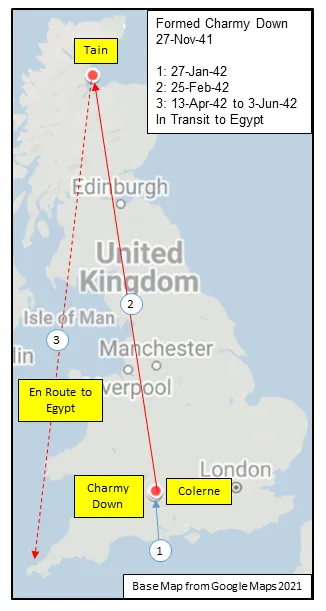
MAP 1: 417 Squadron Movements in Britain 1941-42 (right-click on image to display enlarged in new tab)
|

MAP 2: 417 Squadron Movements in North Africa and Mediterranean Theatre
|
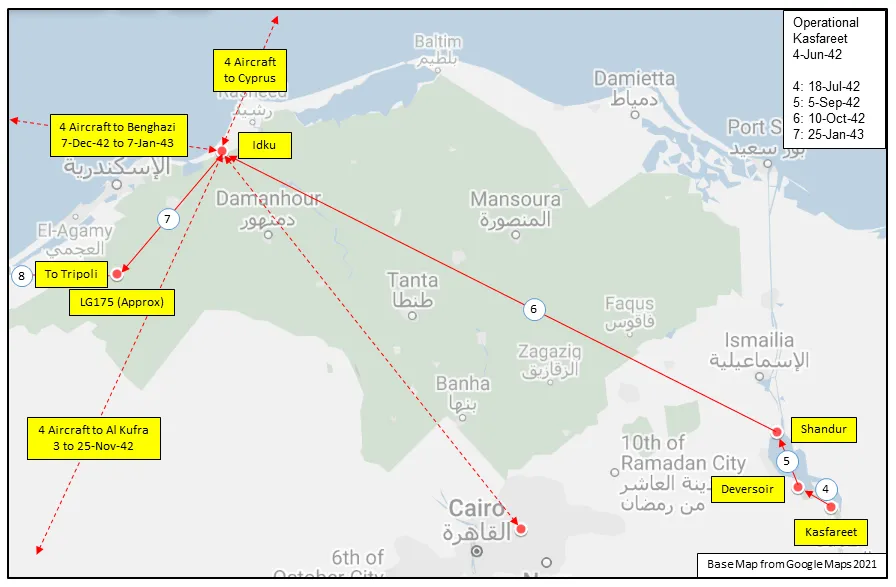
MAP 3: 417 Squadron Movements in Egypt 1942-43 (detail of Map 2)
|

MAP 4: 417 Squadron Movements in Tunisia and Sicily 1943 (detail of Map 2)
|
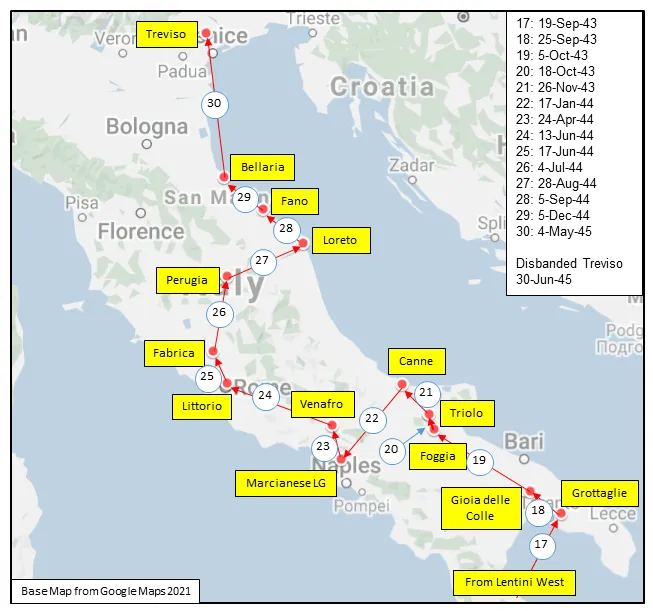
MAP 5: 417 Squadron Movements in Italy 1943-45 (detail of Map 2)
|
417 Squadron History Summary 1941-45

417 Squadron History Summary 1941-45 Page 2
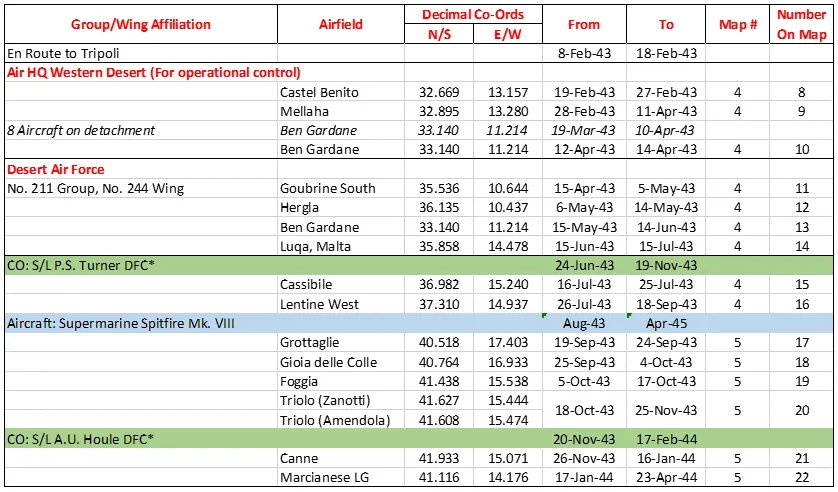
417 Squadron History Summary 1941-45 Page 3
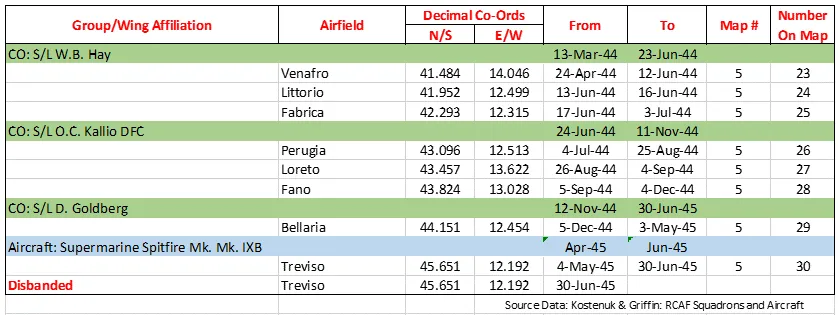
History of the Squadron Post-WWII (Aircraft: Mustang IV, Harvard II, Starfighter, Expeditor, Silver Star, Dragonfly, Huey, Iroquois, Griffon)
417 Squadron was reformed and disbanded twice since its original period of activity. The Squadron was reactivated on June 1, 1947 as a Fighter Reconnaissance Squadron at RCAF Station, Rivers, Manitoba  , where it flew North American Mustangs and Harvards in the close air support role until August 1, 1948, when it was disbanded.
, where it flew North American Mustangs and Harvards in the close air support role until August 1, 1948, when it was disbanded.
Twenty-two years later, in 1970, 417 Squadron was again reformed, but from the No. 6 (Strike and Reconnaissance) Operational Training Unit (OTU) at CFB Cold Lake, Alberta  , which had been training pilots on the CF104 Starfighter since 1961. 417 continued as the CF104 OTU until the Squadron was disbanded in April 1983, as a result of the phasing out of the Starfighter.
, which had been training pilots on the CF104 Starfighter since 1961. 417 continued as the CF104 OTU until the Squadron was disbanded in April 1983, as a result of the phasing out of the Starfighter.
During one of 417 Squadron's periods of inactivity, Base Flight at Cold Lake was formed on 24 August 1954. Its original reason for being was to provide a communications link to Edmonton, then five hours away by road. The Flight performed this with their first Aircraft, a Beechcraft Expeditor. In the process of expanding its role, Base Flight amassed a wide variety and number of aircraft, making it one of the largest and most active flying units in Canada's post-war Air Force. The fleet included H-5 (Dragonfly) and H-34 (Horse) helicopters, de Havilland Otters and the Douglas C-47 Dakotas, three of which were modified with nose cones to efficiently train upcoming CF 104 pilots on air intercept radar systems. Base Flight also employed the T-33 Silver Star as utility transport, airborne target trainer and as an air combat adversary. On the helicopter side, the main roles were, and still are, to rescue downed aircrew and to provide Medical Evacuation services (MEDEVAC) to both military and civilian communities. To fulfil these and other diverse roles, Base Flight added to the two original above-mentioned helicopters by receiving three UH-1 Huey or Iroquois helicopters and later, two CH-135 Twin Huey Aircraft. On April 1, 1993, 417 Squadron was re-formed again, incorporating the Base Flight plus aircraft servicing and maintenance elements of the Wing Maintenance organization.
The mission is now to provide helicopter support to 4 Wing, Cold Lake, by providing a dedicated on base Search and Rescue Unit. The unit’s primary role is to conduct Base rescue for the fighter units on base. Its secondary role is to augment the National Search and Rescue capability.